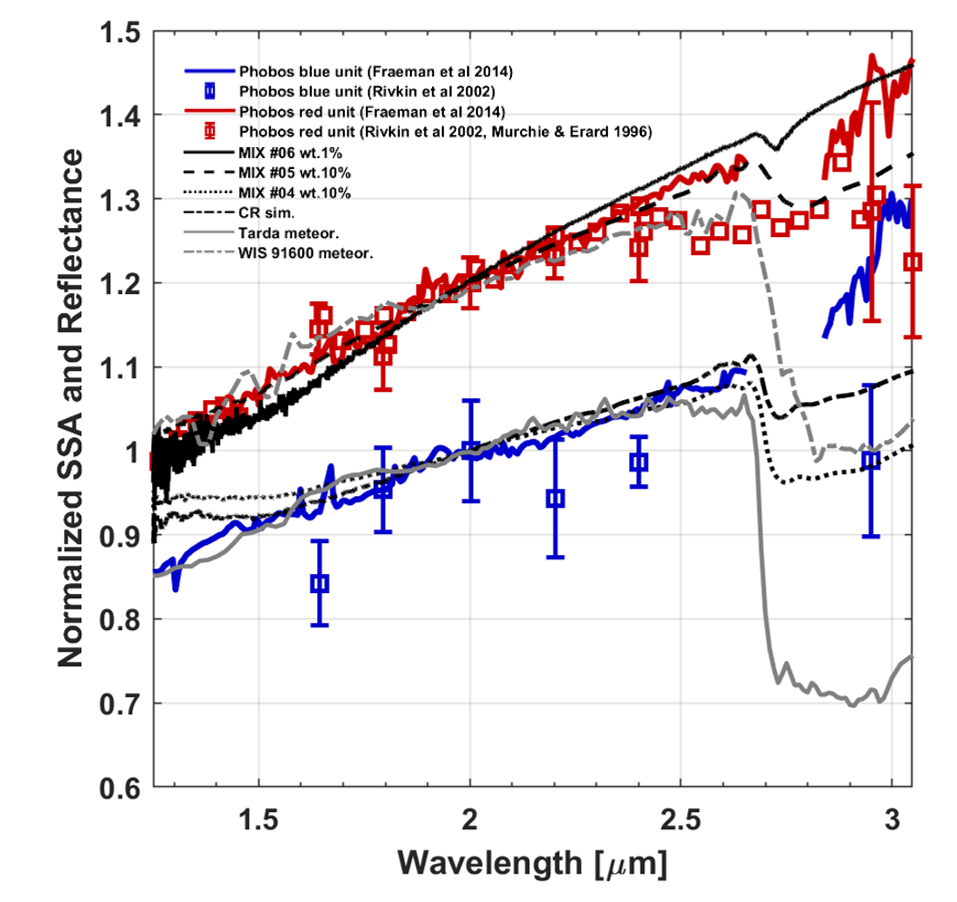Search for Phobos and Deimos spectroscopic analogs: Summary of remote sensing observations and new preliminary laboratory measurements
- 1LESIA-Observatoire de Paris, Université PSL, CNRS, Université Paris Cité, Sorbonne Université, Meudon, France (giovanni.poggiali@obspm.fr)
- 2The Geological Survey of Japan, National Institute of Advanced Industrial Science and Technology, Japan
- 3Institut Universitaire de France (IUF), Paris, France
- 4INAF-Astrophysical Observatory of Arcetri, Firenze, Italy
- 5Université de Grenoble, Laboratoire de Planétologie de Grenoble, Institut de Planétologie et d’Astrophysique de Grenoble, Grenoble, France
- 6Dipartimento di Fisica ed Astronomia, Università degli Studi di Firenze, Sesto Fiorentino (Firenze), Italy
Introduction
Phobos and Deimos' composition are still largely unconstrained today. Although several infrared data have been collected by both spacecraft and ground-based observatories, there is still no conclusive agreement on the interpretation of these data. These uncertainties reflect the ongoing debate on the origin of Martian moons and their evolution. The possible presence of hydrated minerals along with mafic minerals (i.e., olivine and/or pyroxene) seems to be the most plausible interpretation based on previous spectroscopic data obtained in the visible (VIS) to mid infrared range [e.g. 1, 2], but more investigations are needed. MIRS spectrometer [3] onboard the future JAXA MMX spacecraft [4] will help to unveil the open question on the composition of Phobos and Deimos.
In this presentation we will review past spectroscopic observations of the Martian moons, both from ground observatories and spacecraft dataset, aiming at better understanding the constraints in interpreting the Mars satellites composition and at identifying the best spectroscopic analogs. We will also present new laboratory measurements on mineral mixing and meteorites to match the satellites spectral behavior.
Methods
Several samples were studied in this preliminary work in order to select the best analog for Phobos and Deimos surfaces. We worked with several simulants (Mars soil and carbonaceous chondrites) acquired by Exolith Lab funded by Center for Lunar & Asteroid Surface Science at University of Central Florida [5,6]. We added to the sample set a mineral mixture (50/50 wt.% plagioclase bytownite and pyroxene augite) to resemble a basaltic composition, a synthetic amorphous carbon (AC) produced in laboratory by arc discharge and antigorite, one of the common forms of serpentine. New measurements were acquired in two different facilities: INAF-Astrophysical Observatory of Arcetri and IPAG laboratories. The results obtained set new constraints for future laboratory measurements. The main effects studied are: i) the mixing of two components, generally one basaltic and one dark to simulate a possible origin following an impact between Mars and a rocky small body; ii) the effect of the geometry on the spectra in order to evaluate the goodness of comparisons with existing data.

Fig. 1 Comparison between selected spectra of Phobos and laboratory analogs. Spectra of the red unit and blue unit are normalized at 2 μm and offset for clarity. We compared the mixture (black lines) and meteorites (gray lines) showing the best match with the observation. Although the agreement with the slope is pretty good in the studied range, the comparison in the region of the 2.7-μm hydrated band is of lower quality due to both the worse quality of the Phobos spectra and the more intense bands of some laboratory spectra.
Results
The MMX mission will aim to shed light on this topic, and the role of the MIRS spectrometer will be pivotal in this regard. MIRS, with its unprecedented spatial resolution, high S/N and a spectrum without interruption, will allow us to characterize the composition in detail and to investigate heterogeneity associated with the surface morphology. Up to now, despite a good agreement between measurements taken from the ground-based telescope and spacecraft (Figure 1) many possible analogues are suitable to obtain a good match considering also the incompleteness of previous data. In our presentation we will see how by comparing the observations in the VIS/NIR range with the data obtained from instruments in the thermal infrared range it is possible to place constraints on the nature of the surface of Phobos and Deimos. Moreover, we will show some new measurements of mixures trying to set compositional constrain in the mix of carbonaceous and basaltic material at the origin of Phobos and Deimos. We will focus in particular on the plausible amount of hydrated material on the surface of the martian moons.
Acknowledgements
This work was performed in support of future MIRS data interpreation. Simulant samples used in this work were produced by the ExolithLab (Florida Space Institute and The Center for Lunar & Asteroid Surface Science at UCF). They were acquired through the laboratory website or they were shared personally by D. Britt to Arcetri laboratory.
References
[1] Fraeman et al. 2014, Icarus, 299, 196–205
[2] Glotch et al. 2018, JGR planets, 123, 2467–2484
[3] Barucci et al. 2021, Earth Planets and Space, 73, 211
[4] Kuramoto et al. 2022, Earth Planets and Space, 74, 12
[5] Britt et al. 2019, Met & Plan Science 54, 9, 2067–2082
[6] Cannon et al 2019, Icarus, 317, 470-478
How to cite: Poggiali, G., Matsuoka, M., Barucci, M. A., Fornasier, S., Doressoundiram, A., Brucato, J. R., Beck, P., Merlin, F., and Andrew, A.: Search for Phobos and Deimos spectroscopic analogs: Summary of remote sensing observations and new preliminary laboratory measurements, Europlanet Science Congress 2022, Granada, Spain, 18–23 Sep 2022, EPSC2022-953, https://doi.org/10.5194/epsc2022-953, 2022.

